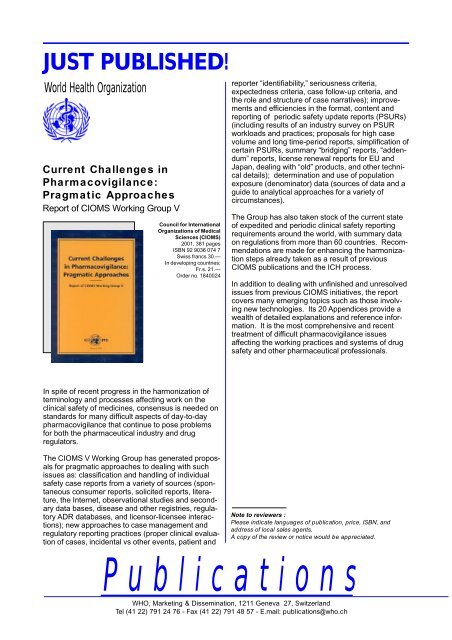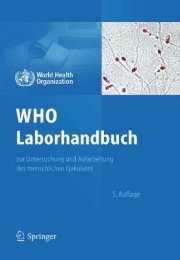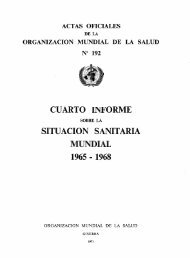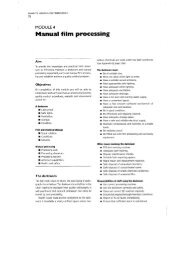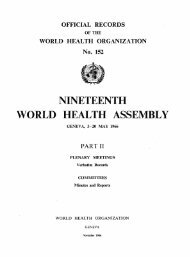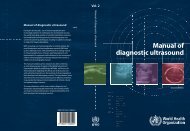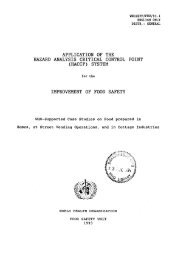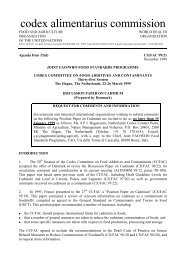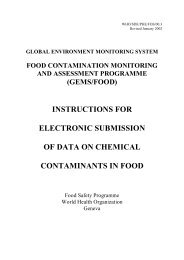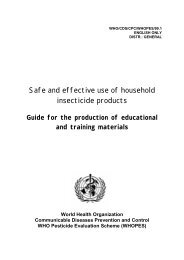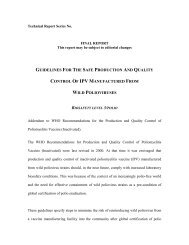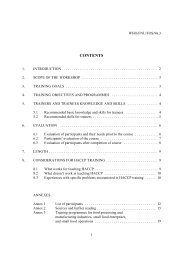Pragmatic Approaches Report of CIOMS Working Group V
Pragmatic Approaches Report of CIOMS Working Group V
Pragmatic Approaches Report of CIOMS Working Group V
Create successful ePaper yourself
Turn your PDF publications into a flip-book with our unique Google optimized e-Paper software.
JUST PUBLISHED!<br />
World Health Organization<br />
Current Challenges in<br />
Pharmacovigilance:<br />
<strong>Pragmatic</strong> <strong>Approaches</strong><br />
<strong>Report</strong> <strong>of</strong> <strong>CIOMS</strong> <strong>Working</strong> <strong>Group</strong> V<br />
Council for International<br />
Organizations <strong>of</strong> Medical<br />
Sciences (<strong>CIOMS</strong>)<br />
2001, 381 pages<br />
ISBN 92 9036 074 7<br />
Swiss francs 30.—<br />
In developing countries:<br />
Fr.s. 21.—<br />
Order no. 1840024<br />
In spite <strong>of</strong> recent progress in the harmonization <strong>of</strong><br />
terminology and processes affecting work on the<br />
clinical safety <strong>of</strong> medicines, consensus is needed on<br />
standards for many difficult aspects <strong>of</strong> day-to-day<br />
pharmacovigilance that continue to pose problems<br />
for both the pharmaceutical industry and drug<br />
regulators.<br />
The <strong>CIOMS</strong> V <strong>Working</strong> <strong>Group</strong> has generated proposals<br />
for pragmatic approaches to dealing with such<br />
issues as: classification and handling <strong>of</strong> individual<br />
safety case reports from a variety <strong>of</strong> sources (spontaneous<br />
consumer reports, solicited reports, literature,<br />
the Internet, observational studies and secondary<br />
data bases, disease and other registries, regulatory<br />
ADR databases, and licensor-licensee interactions);<br />
new approaches to case management and<br />
regulatory reporting practices (proper clinical evaluation<br />
<strong>of</strong> cases, incidental vs other events, patient and<br />
reporter “identifiability,” seriousness criteria,<br />
expectedness criteria, case follow-up criteria, and<br />
the role and structure <strong>of</strong> case narratives); improvements<br />
and efficiencies in the format, content and<br />
reporting <strong>of</strong> periodic safety update reports (PSURs)<br />
(including results <strong>of</strong> an industry survey on PSUR<br />
workloads and practices; proposals for high case<br />
volume and long time-period reports, simplification <strong>of</strong><br />
certain PSURs, summary “bridging” reports, “addendum”<br />
reports, license renewal reports for EU and<br />
Japan, dealing with “old” products, and other technical<br />
details); determination and use <strong>of</strong> population<br />
exposure (denominator) data (sources <strong>of</strong> data and a<br />
guide to analytical approaches for a variety <strong>of</strong><br />
circumstances).<br />
The <strong>Group</strong> has also taken stock <strong>of</strong> the current state<br />
<strong>of</strong> expedited and periodic clinical safety reporting<br />
requirements around the world, with summary data<br />
on regulations from more than 60 countries. Recommendations<br />
are made for enhancing the harmonization<br />
steps already taken as a result <strong>of</strong> previous<br />
<strong>CIOMS</strong> publications and the ICH process.<br />
In addition to dealing with unfinished and unresolved<br />
issues from previous <strong>CIOMS</strong> initiatives, the report<br />
covers many emerging topics such as those involving<br />
new technologies. Its 20 Appendices provide a<br />
wealth <strong>of</strong> detailed explanations and reference information.<br />
It is the most comprehensive and recent<br />
treatment <strong>of</strong> difficult pharmacovigilance issues<br />
affecting the working practices and systems <strong>of</strong> drug<br />
safety and other pharmaceutical pr<strong>of</strong>essionals.<br />
Note to reviewers :<br />
Please indicate languages <strong>of</strong> publication, price, ISBN, and<br />
address <strong>of</strong> local sales agents.<br />
A copy <strong>of</strong> the review or notice would be appreciated.<br />
P u b l i c a t i o n s<br />
WHO, Marketing & Dissemination, 1211 Geneva 27, Switzerland<br />
Tel (41 22) 791 24 76 - Fax (41 22) 791 48 57 - E.mail: publications@who.ch
Table <strong>of</strong> contents<br />
1. Introduction<br />
a. Background<br />
b. Privacy and the protection <strong>of</strong> personal health data<br />
c. Overview<br />
2. Sources <strong>of</strong> individual case<br />
reports<br />
a. Introduction<br />
b. Spontaneous reports from persons other than<br />
healthcare pr<strong>of</strong>essionals<br />
c. Literature<br />
d. The Internet<br />
e. Solicited reports<br />
f. Aspects <strong>of</strong> clinical trials reports<br />
g. Epidemiology<br />
h. Disease-specific registries and regulatory ADR<br />
databases<br />
i. Licensor-license interactions<br />
3. Good case management<br />
practices<br />
a. Introduction<br />
b. Assessing patient and reporter identifiability<br />
c. Criteria for seriousness<br />
d. Criteria for expectedness<br />
e. Case follow-up approaches<br />
f. Role <strong>of</strong> narratives<br />
Please send me____ copies <strong>of</strong> Current Challenges in<br />
Pharmacovigilance: <strong>Pragmatic</strong> <strong>Approaches</strong> at the price<br />
<strong>of</strong> Sw.fr. 30.--/In developing countries Sw.fr. 21.-- (order<br />
no. 1840024)<br />
Name<br />
Address<br />
Just Published!<br />
ORDER FORM<br />
4. Good summary reporting<br />
practices PSURs reconsidered<br />
a. Introduction<br />
b. Results <strong>of</strong> a survey on PSUR workloads<br />
c. Proposals for PSUR content modification<br />
d. Proposals relating to frequency and timing <strong>of</strong> reporting<br />
e. Miscellaneous proposals for managing PSURS<br />
5. Determination and use <strong>of</strong><br />
population exposure data<br />
a. Introduction<br />
b. Periodic safety update reports and exposure data<br />
sources<br />
c. Technical considerations<br />
d. Spontaneous reporting and patient exposure<br />
e. Real examples <strong>of</strong> denominator determination and use<br />
f. Patient-exposure and measurements <strong>of</strong> risk<br />
6. Clinical safety reporting<br />
regulations: an overview<br />
a. Introduction<br />
b. Basis for comparison <strong>of</strong> regulations<br />
c. Current state <strong>of</strong> affairs<br />
d. Recommendations<br />
e. Conclusion<br />
7. Summary <strong>of</strong> proposals<br />
8. Appendices<br />
9. Index<br />
Payment enclosed<br />
Please charge to my credit card<br />
Visa American Express Diners Club<br />
Eurocard/Access/Mastercard<br />
Card No.<br />
Expiry date<br />
Date <strong>of</strong> order<br />
Signature<br />
MDI.CIO.201<br />
W H O • M a r k e t i n g & D i s s e m i n a t i o n • 1 2 1 1 G e n e v a 2 7 • S w i t z e r l a n d<br />
Tel.: (41 22) 791 24 76 - Fax : (41 22) 791 48 57 - E.mail.: bookorders@who.ch


